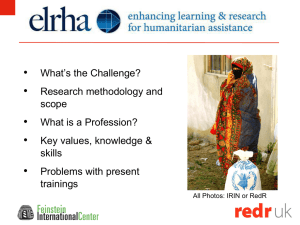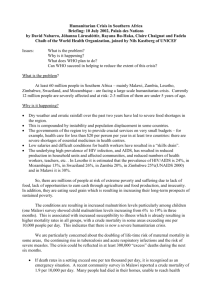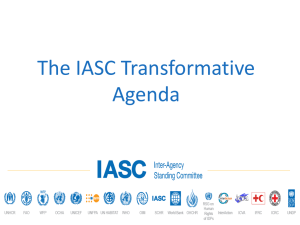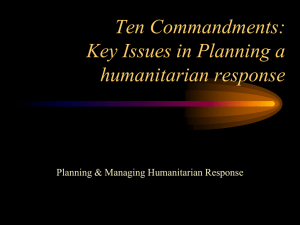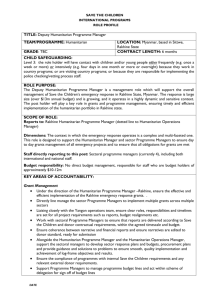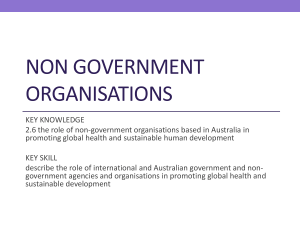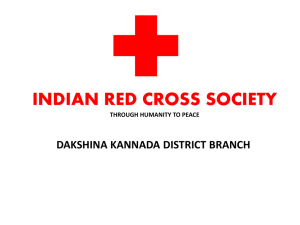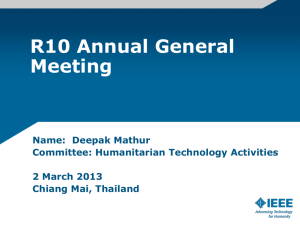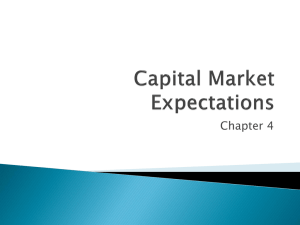Exploring acceptable levels of uncertainty within the joint
advertisement
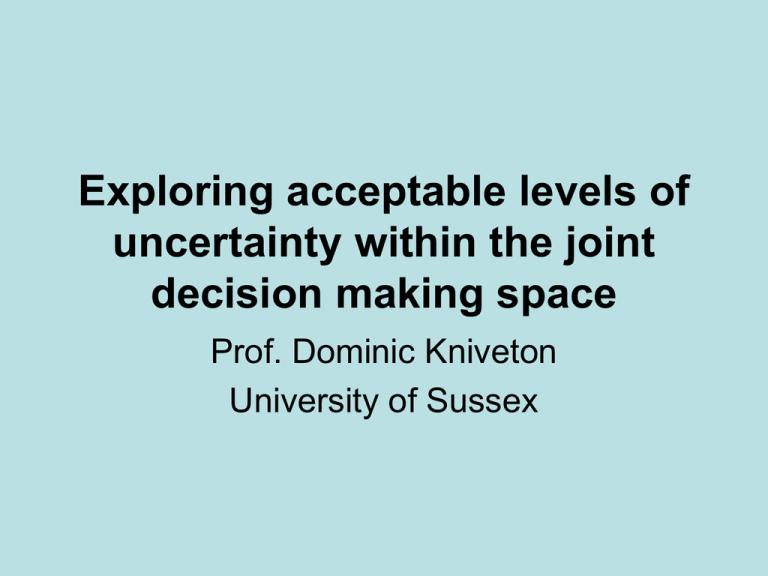
Exploring acceptable levels of uncertainty within the joint decision making space Prof. Dominic Kniveton University of Sussex The humanitarian community and the 2011 Horn of Africa crisis • Humanitarian response was a response to a emergency that was already underway; • despite being warned of a high possibility that it might occur before the event • Desire to develop a more anticipatory approach using science to both predict and prepare for future disasters Humanitarian community Comprises • providers, such as donor governments, foundations and individual givers; • delivering agencies including the Red Cross and Red Crescent Movement, NGOs, and UN Agencies; • those affected by crises, not only as victims but also as implementers of their own response, including national governments, local NGOs and communities themselves Donors Delivering agencies National governments Local communities Climate science community Comprises • providers, such as donor governments, foundations and individual givers; • delivering agencies including research institutions and universities • those using science and developing their own climate information, including national governments, local NGOs and communities themselves Donors Delivering agencies National governments Local communities A dangerous delay • Decision-maker ill ease at acting upon forecasts that are inherently uncertain. – in acting on uncertain forecasts, fear of the impact on finances and reputation if the forecasts fail to be accurate; – of being seen as too interventionist, and so undermining community’s own coping capacity if they become involved before crises are fully in flow; – and of risking donor fatigue if the number of forecasts requiring action increases. Being taken seriously • factors affecting the take-up of early warning information – the ownership of the information with donor agencies cited as being sceptical of early warning information provided by some national governments. – how the early warning information is interpreted e.g. how to interpret probabilities. • donor bureaucracies and the use of early warning information; – rigidity of the humanitarian system has also been highlighted as an impediment to the use of early warning information. For example the misalignment of the timeline of UN appeals with the seasons in the horn of Africa has been cited as contributing to the underestimation of the number of people needing aid in the 2011 crisis – how to design actions based on probabilities • political factors influencing decision making is acted upon where populations rely on national and international assistance Margaret Buchanan-Smith 2000. Role of early warning systems in decision making process. ODI Climate scientists Households and communities Reputation based around publications from mainly within the scientific community Perceived and actual ability to act Access to funding for research Subjective norms Institutional and individual research agendas within climate science Shared decision space Social discourse on risk Reputation, credibility and access to funders Profile to stakeholders Reputation (and therefore access) to nation states International humanitarian system Complex Adaptive Systems Systems involving ‘nested hierarchies, a multiplicity of cross-scale interactions and feedback loops between different hierarchical levels characterised by a high degree of complexity and non-linear behaviour that predictive equilibrium models fail to calculate’ (Rammel et al 2007) UN Agencies Weather and Climate Scientists Mobile Phones Internet Radio Newspapers Faith Networks Markets Chiefs’ Meetings Key Actors Information flows Feedback loops Government and Regional and International Organisations GOs (I)NGOs, UN Agencies and Red Cross/Crescent Community Mobile Phones Internet Radio Newspapers Faith Networks Markets Chiefs’ Meetings Adaptive co-management Promoting collaboration between the epistemic communities through pluralism and linkages across multiple actors, communication and negotiation between the different communities; by promoting transactive decision making whereby policy/practice decisions are regarded as flexible and adaptive rather than definitive solutions; and rather than focusing on certainties making an explicit recognition of uncertainties and an emphasis on social learning and the co-evolution of knowledge (Plummer and Armitage 2007). UN Agencies Weather and Climate Scientists Mobile Phones Internet Radio Newspapers Faith Networks Markets Chiefs’ Meetings Key Actors Information flows Feedback loops Government and Regional and International Organisations GOs (I)NGOs, UN Agencies and Red Cross/Crescent Community Mobile Phones Internet Radio Newspapers Faith Networks Markets Chiefs’ Meetings An anticipatory approach Uncertainty Probabilities A general, overarching term referring to ambiguities, indeterminateness, or lack of exactness in forecasts Hirschberg and Abrams (2011) Risk The combination of the probability of an event and its negative consequences. (UNISDR) Uncertainty and climate science • generates a rationale for research • a fundamental characteristic of predictions of the state of the atmosphere over time. – while the exact state of the atmosphere is impossible to forecast precisely, some general patterns of the atmosphere have some predictability (in terms of probabilities of occurrence) Uncertainty and probability • Ensemble runs • Multi-model runs • Sample of the total probability distribution Greater Horn of Africa Consensus Climate Outlook for the September to December 2010 100 90 80 Start of wet season Probability of occurrence 70 60 below average average above average 50 40 30 20 10 0 0 2 4 6 8 10 12 14 16 Weeks before end of wet season 18 20 22 24 26 70 60 Accuracy (%) 50 40 50% chance of below average rainfall 40% chance of below average rainfall 30% chance of below average rainfall 30 20 10 0 0 1 2 3 4 5 6 Months before rains 7 8 9 10 Contributing factors Food Availability, Access, Utilization, Stability Human Water Requirement from Improved Source Hazards & Vulnerability Integrated Food Security Phase Classification's (IPC) Acute Food Insecurity Reference Table for Household Groups Concluding thoughts • The science community needs to engage with the humanitarian system and its demand for information on risk. • During this process, questions and solutions will arise as to what information is needed on the climate, what is producible and how it can be used. • Possible starting positions for this dialogue include for climate science illustrating the variability and extent of uncertainty over time and space, associated with different climate forecasts and products. • While for the humanitarian system this could include illustrating how an anticipatory risk management based humanitarian system will work in practice. For example exploring how the uncertainty in probabilistic climate information propagates through such decision support tools as predictive livelihood analysis (Levine et al 2011) and thus how it may lead to flexible and adaptive policies and actions.



